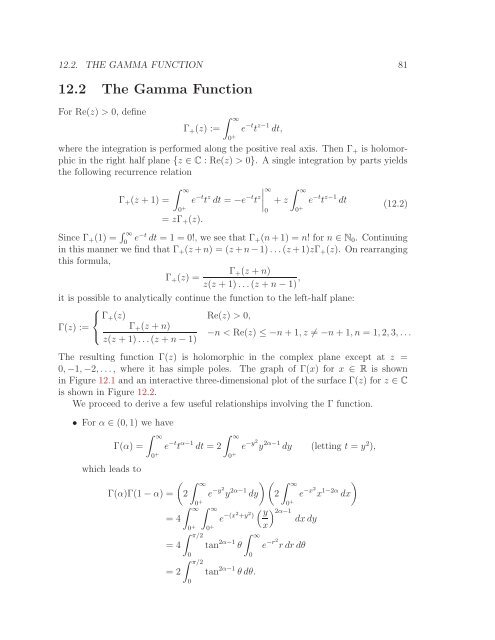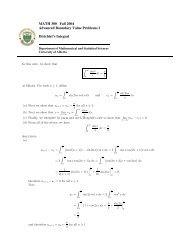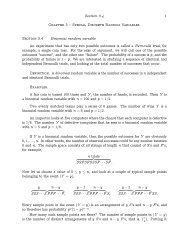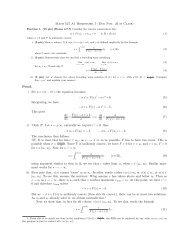Math 411: Honours Complex Variables - University of Alberta
Math 411: Honours Complex Variables - University of Alberta
Math 411: Honours Complex Variables - University of Alberta
Create successful ePaper yourself
Turn your PDF publications into a flip-book with our unique Google optimized e-Paper software.
12.2. THE GAMMA FUNCTION 81<br />
12.2 The Gamma Function<br />
For Re(z) > 0, define<br />
Γ+(z) :=<br />
� ∞<br />
0 +<br />
e −t t z−1 dt,<br />
where the integration is performed along the positive real axis. Then Γ+ is holomorphic<br />
in the right half plane {z ∈ C : Re(z) > 0}. A single integration by parts yields<br />
the following recurrence relation<br />
� ∞<br />
Γ+(z +1) = e (12.2)<br />
−t t z dt = −e −t t z<br />
�∞<br />
�<br />
� ∞<br />
�<br />
� +z e −t t z−1 dt<br />
0 +<br />
= zΓ+(z).<br />
Since Γ+(1) = � ∞<br />
0 e−t dt = 1 = 0!, we see that Γ+(n+1) = n! for n ∈ N0. Continuing<br />
in this manner we find that Γ+(z+n) = (z+n−1)...(z+1)zΓ+(z). On rearranging<br />
this formula,<br />
Γ+(z) =<br />
0<br />
0 +<br />
Γ+(z +n)<br />
z(z +1)...(z +n−1) ,<br />
it is possible to analytically continue the function to the left-half plane:<br />
⎧<br />
⎨Γ+(z)<br />
Re(z) > 0,<br />
Γ(z) := Γ+(z +n)<br />
⎩<br />
−n < Re(z) ≤ −n+1,z �= −n+1,n = 1,2,3,...<br />
z(z +1)...(z +n−1)<br />
The resulting function Γ(z) is holomorphic in the complex plane except at z =<br />
0,−1,−2,..., where it has simple poles. The graph <strong>of</strong> Γ(x) for x ∈ R is shown<br />
in Figure 12.1 and an interactive three-dimensional plot <strong>of</strong> the surface Γ(z) for z ∈ C<br />
is shown in Figure 12.2.<br />
We proceed to derive a few useful relationships involving the Γ function.<br />
• For α ∈ (0,1) we have<br />
Γ(α) =<br />
which leads to<br />
�<br />
Γ(α)Γ(1−α) = 2<br />
� ∞<br />
0 +<br />
e −t t α−1 � ∞<br />
dt = 2<br />
0 +<br />
= 4<br />
� ∞<br />
0 +<br />
� ∞<br />
0 +<br />
� ∞<br />
0 +<br />
e −(x2 +y2 )<br />
� π/2 � ∞<br />
e −y2<br />
y 2α−1 dy (letting t = y2 ),<br />
e −y2<br />
y 2α−1 ��<br />
dy 2<br />
= 4 tan<br />
0<br />
2α−1 θ<br />
� π/2<br />
0<br />
= 2 tan 2α−1 θdθ.<br />
0<br />
�<br />
y<br />
x<br />
� ∞<br />
0 +<br />
�2α−1 e −x2<br />
x 1−2α �<br />
dx<br />
dxdy<br />
e −r2<br />
rdrdθ







